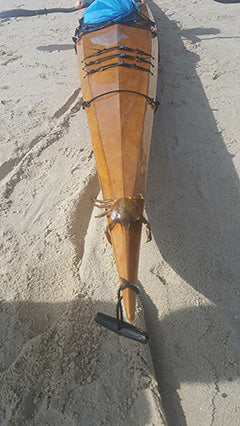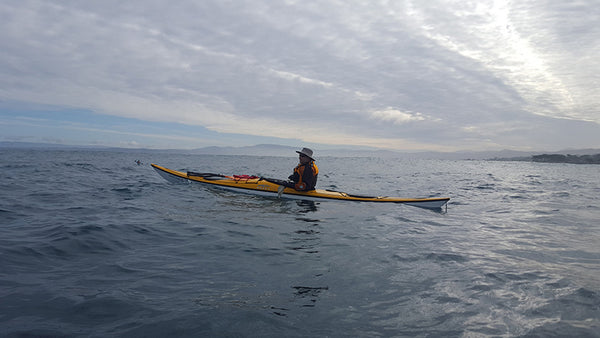[ Cali Paddler welcomes Team Writer Bret Warner who shares his knowledge and experience of sea kayaking for paddlers who have tried the other craft, but never had the chance to try this this venerable and fun vessel. ]
 When I got into SUP and SUP racing years ago and I saw how interwoven it was with outrigger, prone and surf-ski races I was a confused why kayaking seemed to be the eccentric loner uncle of the paddling world. I learned to sea kayak with my dad when I was 12, and taught sea and surf kayaking all through college. I even played kayak polo a handful of times, so to not see any kayaks in the SoCal paddling scene was completely outside of my paddling paradigm.
When I got into SUP and SUP racing years ago and I saw how interwoven it was with outrigger, prone and surf-ski races I was a confused why kayaking seemed to be the eccentric loner uncle of the paddling world. I learned to sea kayak with my dad when I was 12, and taught sea and surf kayaking all through college. I even played kayak polo a handful of times, so to not see any kayaks in the SoCal paddling scene was completely outside of my paddling paradigm.
 After talking to people about it and thinking on it the reasons do, however, seem pretty clear. Sea kayaks, and I am referring to the more traditional sit inside sea kayaks not your stack-able plastic sit on tops, are intimidating. To be safe, you need to take a lesson and learn how to climb back in your boat if you fall out. Even after that getting back in a sea kayak is decidedly more work than just clambering back on your OC-1/Surfski/Paddleboard/SUP. You also need more gear. Like other craft a sea kayak requires a paddle and a PFD, but it also needs a spray-skirt, that silly thing sea kayakers wear around their waist, and in colder temperatures you need a jacket that is designed specifically to keep water out of the aforementioned spray-skirt. On top of all that sea kayaking looks too hot, at least to many southern Californians who wear board-shorts as a primary article of clothing whether they are paddling or not. (Note, I am one of these people).
After talking to people about it and thinking on it the reasons do, however, seem pretty clear. Sea kayaks, and I am referring to the more traditional sit inside sea kayaks not your stack-able plastic sit on tops, are intimidating. To be safe, you need to take a lesson and learn how to climb back in your boat if you fall out. Even after that getting back in a sea kayak is decidedly more work than just clambering back on your OC-1/Surfski/Paddleboard/SUP. You also need more gear. Like other craft a sea kayak requires a paddle and a PFD, but it also needs a spray-skirt, that silly thing sea kayakers wear around their waist, and in colder temperatures you need a jacket that is designed specifically to keep water out of the aforementioned spray-skirt. On top of all that sea kayaking looks too hot, at least to many southern Californians who wear board-shorts as a primary article of clothing whether they are paddling or not. (Note, I am one of these people).

Having said all this let me be clear: sea kayaking is still totally worth it. You do need to learn how to re-enter your kayak, but if you learn how to roll your kayak the need to re-enter lessens because you won’t fall out in the first place. For those of you who have fallen in rough waters imagine how great it would have been to never be separated from your craft and be back up and moving in just a few seconds. Additionally, once you can roll you open the door to lean turns and braces that will drastically improve the control and maneuverability of your boat. You can lean a sea kayak on its side and then turn it much more efficiently than another boat of comparable length while on its hull. Essentially you can become one with your craft in ways that other paddle craft do not allow. This is where the spray skirt comes in.

My paddler soul wails in anguish every time I see someone in a sea kayak without a skirt. Even on flat water there may be times when you need to lean the boat on its side to turn, or even just to cool off. If you paddle without a skirt you can’t do this without getting a ton of water in your boat. Additionally, sea kayaking can drastically enhance your overall paddling skills. Aside from getting a more efficient forward stroke, although time in any paddlecraft is always good cross training, the fact that you are literally inside your craft allows you to manipulate the boat in ways that are impossible in anything else. This allows you to experiment with different types of braces to lay the boat on its side, keep from falling, or just to cool down. It allows for the aforementioned lean turn. While it is possible to make directional corrections on many craft by leaning, the design of the kayak allows you to lean much farther without falling out, and thus control the boat more without the use of a rudder. Many sea kayaks have rudders, but you will find many sea kayakers who fervently denounce them as well, and choose to opt for a drop down skeg instead. I have used paddle techniques I learned in sea kayaking in every craft I have paddled. I have applied sea kayaking style braces, albeit at a very different angle, while down-winding or surfing a SUP or Outrigger. Buoy turns on a SUP have a very similar paddle path as a lean turn on a sea kayak, even the lean turns one does in a kayak when not using the paddle can be analogous to a prone board that responds to a lean for directional corrections.

I realize that with all this there is still no racing scene for sea kayaks, at least in many areas where the race scene for other paddlesports is so robust. But I will point out that there are a few race specific sea kayaks that have a surf-ski style hull with a sea kayak deck. Many are made from kits or plans like the Mystery from CLC or the Sea Racer from Bjorn Thomassen, but some, like Valley Kayaks’ Rapier are a stock design that doesn’t require hours of work and a knowledge of woodworking and glassing. Even without a race boat, however, the ability to be one with your boat is a feeling you can’t get in any other craft, and a way to hone your paddling skills that you cannot do unless you are in a sea kayak.

[Photo credit and gratitude to Bud Miller]
 Team Writer Bret Warner - Paddling truly got its hooks into me when I, on a whim, watched the 1999 Santa Cruz Paddlefest with my dad. I had kayaked a little before, but from then on the addiction was palpable. My first kayak, a purple and turquoise Necky Rip, came soon after. The following year I was that kid at UCSD who had a surf kayak in the common study area instead of a surfboard in my dorm room. I also taught sea kayaking all through college in San Diego, and up in Santa Cruz after I graduated.
Team Writer Bret Warner - Paddling truly got its hooks into me when I, on a whim, watched the 1999 Santa Cruz Paddlefest with my dad. I had kayaked a little before, but from then on the addiction was palpable. My first kayak, a purple and turquoise Necky Rip, came soon after. The following year I was that kid at UCSD who had a surf kayak in the common study area instead of a surfboard in my dorm room. I also taught sea kayaking all through college in San Diego, and up in Santa Cruz after I graduated.
When SUP came around, however, the paddling addiction became even more rabid. The garage started to fill up with different types of boards, and is now more than half full of hollow wood boards I have built myself,both for environmental reasons, and because it’s awesome to get to talk about how you built your own board when people ask you about it after a race. I love the paddle racing scene in California right now. Everyone is so stoked to be on the water competing, and the fierce competition is matched by the smiling faces when the race is over. I have gotten to paddle crafts that I never really considered before, and can see myself getting hooked all over again on something else: prone, OC-1, surfski,whatever, I just need more garage space.
Three years ago I founded the non-profit Stand up to Alzheimer’s. An organization that raises money and awareness for Alzheimer’s research through paddle races. This organization was born from lacking a tangible way of dealing with my father’s diagnosis with Alzheimer’s, but has now become a way, hopefully, for other to help cope as well. Visit us at www.sup2alzh.weebly.com.
















Comments